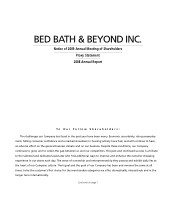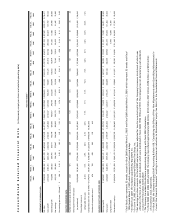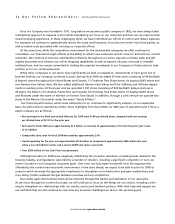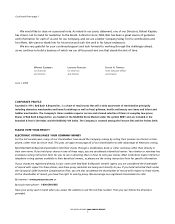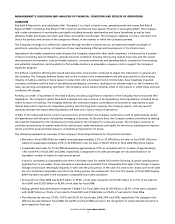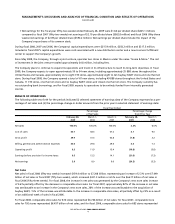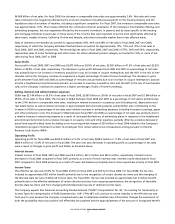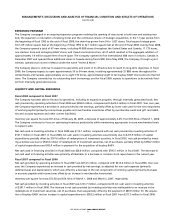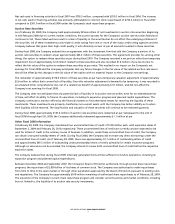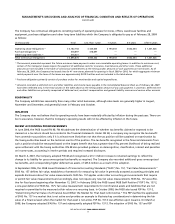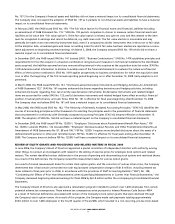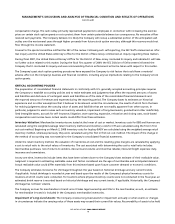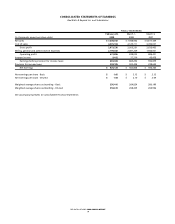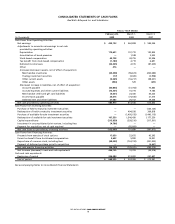Bed, Bath and Beyond 2008 Annual Report Download - page 11
Download and view the complete annual report
Please find page 11 of the 2008 Bed, Bath and Beyond annual report below. You can navigate through the pages in the report by either clicking on the pages listed below, or by using the keyword search tool below to find specific information within the annual report.BED BATH & BEYOND 2008 ANNUAL REPORT
9
No. 157-3 for the Company’s financial assets and liabilities did not have a material impact on its consolidated financial statements.
The Company does not expect the adoption of SFAS No. 157 as it pertains to non-financial assets and liabilities to have a material
impact on its consolidated financial statements.
In February 2007, the FASB issued SFAS No. 159, “The Fair Value Option for Financial Assets and Financial Liabilities–Including
an amendment of FASB Statement No. 115.” SFAS No. 159 permits companies to choose to measure certain financial assets and
liabilities at fair value (the “fair value option”). If the fair value option is elected, any upfront costs and fees related to the item
must be recognized in earnings and cannot be deferred, e.g. debt issue costs. The fair value election is irrevocable and may
generally be made on an instrument-by-instrument basis, even if a company has similar instruments that it elects not to fair value.
At the adoption date, unrealized gains and losses on existing items for which fair value has been elected are reported as a cumu-
lative adjustment to beginning retained earnings. On March 2, 2008, the Company adopted SFAS No. 159 which did not have a
material impact on its consolidated financial statements.
In December 2007, the FASB issued SFAS No. 141 (revised 2007), “Business Combinations.” SFAS No. 141R establishes principles and
requirements for how the acquirer in a business combination recognizes and measures in its financial statements the identifiable
assets acquired, the liabilities assumed and any noncontrolling interest in the acquiree at the acquisition date fair value. SFAS No.
141R determines what information to disclose to enable users of the financial statements to evaluate the nature and financial
effects of the business combination. SFAS No. 141R applies prospectively to business combinations for which the acquisition date
is on or after the beginning of the first annual reporting period beginning on or after December 15, 2008. Early adoption is not
permitted.
In March 2008, the FASB issued SFAS No. 161, “Disclosures about Derivative Instruments and Hedging Activities–An Amendment
of FASB Statement 133.” SFAS No. 161 requires enhanced disclosures regarding derivatives and hedging activities, including
enhanced disclosures regarding how: (a) an entity uses derivative instruments; (b) derivative instruments and related hedged
items are accounted for under SFAS No. 133; and (c) derivative instruments and related hedged items affect an entity’s financial
position, financial performance, and cash flows. SFAS No. 161 is effective for fiscal years beginning after November 15, 2008.
The Company does not believe SFAS No. 161 will have a material impact on its consolidated financial statements.
In May 2008, the FASB issued SFAS No. 162, “The Hierarchy of Generally Accepted Accounting Principles.” SFAS 162 identifies the
sources of accounting principles and the framework for selecting the principles used in the presentation of financial statements
that are presented in conformity with Generally Accepted Accounting Principles. SFAS 162 became effective on November 15,
2008. The adoption of SFAS No. 162 did not have a material impact on the Company’sconsolidated financial statements.
In December 2008, the FASB issued FSP No. 132(R)-1, “Employers’ Disclosures about Postretirement Benefit Plan Assets.” FSP
No. 132(R)-1 amends SFAS No. 132 (revised 2003), “Employers’ Disclosures about Pensions and Other Postretirement Benefits–an
Amendment of FASB Statements No. 87, 88 and 106.” FSP No. 132(R)-1 requires more detailed disclosures about the assets of a
defined benefit pension or other post retirement plan. FSP No. 132(R)-1 is effective for fiscal years ending after December 15,
2009. The Company does not believe FSP No. 132(R)-1 will have a material impact on its consolidated financial statements.
REVIEW OF EQUITY GRANTS AND PROCEDURES AND RELATED MATTERS IN FISCAL 2006
In June 2006, the Company’s Board of Directors appointed a special committee of independent directors with authority, among
other things, to conduct an investigation with respect to the setting of exercise prices for employee stock options and related
matters. The review identified various deficiencies in the process of granting and documenting stock options and restricted shares.
As a result of the deficiencies, the Company revised the measurement dates for various option grants.
As a result of revised measurement dates for certain stock option grants, and the correction of various other errors, the Company
determined that it had certain unrecorded non-cash equity-based compensation charges of $61.8 million, including related tax
items related to fiscal years prior to 2006. In accordance with the provisions of Staff Accounting Bulletin (“SAB”) No. 108,
“Considering the Effects of Prior Year Misstatements when Quantifying Misstatements in Current Year Financial Statements,” the
Company decreased beginning retained earnings for fiscal 2006 by $61.8 million within the accompanying Consolidated Financial
Statements.
The Company’sBoardof Directors also approved a remediation program intended to protect over 1,600 employees from certain
potential adverse tax consequences. These adverse tax consequences arise pursuant to Internal Revenue Code Section 409A
as a result of historical deficiencies associated with certain of the Company’s stock option grants that were disclosed through
the Company’sstock option review.As a result of this program, the Company made cash payments totaling approximately
$30.0 million to over 1,600 employees in the fourth quarter of fiscal 2006, which resulted in a non-recurring, pre-tax stock-based

